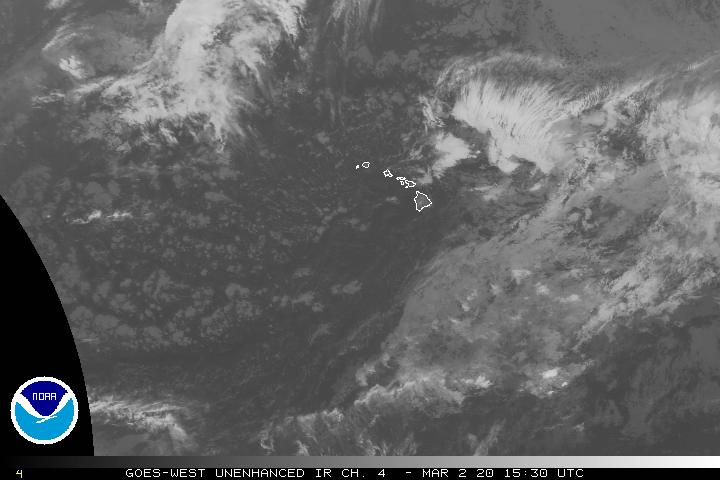Air Temperatures – The following high temperatures (F) were recorded across the state of Hawaii Thursday…along with the low temperatures Thursday:
79 – 72 Lihue, Kauai
82 – 72 Honolulu, Oahu
79 – 65 Molokai
81 – 52 Kahului AP, Maui – broke the low temp record for the date…which was 55 back in 1971
80 – 65 Kailua Kona
83 – 61 Hilo AP, Hawaii
Here are the latest 24-hour precipitation totals (inches) for each of the islands Thursday evening:
0.09 Mount Waialeale, Kauai
0.01 Poamoho, Oahu
0.00 Molokai
0.00 Lanai
0.00 Kahoolawe
0.00 Maui
0.02 Saddle Quarry, Big Island
The following numbers represent the strongest wind gusts (mph) Thursday evening:
31 Port Allen, Kauai
27 Oahu Forest NWR, Oahu
28 Molokai
25 Lanai
38 Kahoolawe
30 Kahului AP, Maui
28 Kealakomo, Big Island
Hawaii’s Mountains – Here’s a link to the live webcam on the summit of our tallest mountain Mauna Kea (nearly 13,800 feet high) on the Big Island of Hawaii. Here’s the webcam for the Haleakala Crater on Maui. These webcams are available during the daylight hours here in the islands, and at night whenever there’s a big moon shining down. Also, at night you will be able to see the stars — and the sunrise and sunset too — depending upon weather conditions.
Aloha Paragraphs

High pressure northeast…several lows far north and northwest

High cirrus northwest through northeast of the state

Clear to partly cloudy…a few cloudy areas

A few showers – Looping image
~~~ Hawaii Weather Narrative ~~~
Small Craft Advisory…Maalaea Bay, Pailolo and Alenuihaha Channels, Big Island leeward and southeast waters
Broad Brush Overview: The current trade wind pattern will hold through the weekend into early next week, as high pressure prevails to the north and northeast of the state. A slight increase in moisture over the weekend into Monday, may lead to better windward shower coverage, with moderate to locally strong trades continuing. There’s a possible change in store next week, as a cold front and upper trough approach the islands.
Details: The abundance of dry air and deep layer ridging continue to limit shower development. Any showers that do develop will be brief with minimal accumulations across the board. This trend is expected to continue through Friday with the locally rather strong trades remaining active into Monday. The models are suggesting a slight increase in moisture arriving with the trades during the weekend…mostly affecting the windward sides.
Looking Further Ahead: The models go on to point out a possible break down of the current, rather benign trade wind weather pattern next week, as a trough of low pressure, and its associated cold front approach the state by next Tuesday into Wednesday. This is still a ways out however, and this outlook may need to be adjusted some over the next several days, as additional model runs work out the finer details. Thereafter, look for a mostly dry…light to moderately strong trade wind weather pattern.
Here’s a wind profile of the Pacific Ocean – Closer view of the islands / Here’s the vog forecast animation / Here’s the latest weather map
Marine environment details: The current northwest swell will continue to lower. The next northwest swell is expected to arrive Friday night. The latest model runs have backed off a bit on the height of this swell, but the swell would still produce advisory level surf this weekend. The swell is expected to peak Saturday afternoon into the evening, before slowly lowering Sunday. The swell will have a more westerly component than the current one, so look for it to reach the west shores of the Big Island, while Kauai may block some of the energy from reaching Oahu. Following this swell, the next moderately large northwest swell looks to arrive Monday night and Tuesday.
World-wide Tropical Cyclone activity
>>> Here’s the latest PDC Weather Wall Presentation, covering Tropical Cyclone 03S (Ava) in the South Indian Ocean…and a tropical disturbance, being referred to as Invest 95S with a low chance of developing in the South Indian Ocean
![]()
>>> Atlantic Ocean:
>>> Caribbean Sea:
>>> Gulf of Mexico:
Here’s a satellite image of the Caribbean Sea…and the Gulf of Mexico
Here’s the link to the National Hurricane Center (NHC)
>>> Eastern Pacific:
Here’s a wide satellite image that covers the entire area between Mexico, out through the central Pacific…to the International Dateline.
Here’s the link to the National Hurricane Center (NHC)
>>> Central Pacific:
Here’s a link to the Central Pacific Hurricane Center (CPHC)
>>> Northwest Pacific Ocean: No active tropical cyclones
>>> North and South Indian Oceans / Arabian Sea:
Tropical Depression 03S (Ava)
JTWC textual forecast warning
JTWC graphical track map
NOAA satellite image
Here’s a link to the Joint Typhoon Warning Center (JTWC)
Interesting: The Bottom of the Ocean Is Sinking – The bottom of the ocean is more of a “sunken place” than it used to be.
In recent decades, melting ice sheets and glaciers driven by climate change are swelling Earth’s oceans. And along with all that water comes an unexpected consequence — the weight of the additional liquid is pressing down on the seafloor, causing it to sink.
Consequently, measurements and predictions of sea-level rise may have been incorrect since 1993, underestimating the growing volume of water in the oceans due to the receding bottom, according to a new study.
Scientists have long known that Earth’s crust, or outer layer, is elastic: Earlier research revealed how Earth’s surface warps in response to tidal movements that redistribute masses of water; and 2017’s Hurricane Harvey dumped so much water on Texas that the ground dropped 0.8 inches.
In the new investigation, researchers looked at more long-term impacts to the seafloor. They evaluated how much the shape of the ocean bottom may have changed between 1993 and 2014, taking into account the amount of water added to the ocean from liquid formerly locked up on land as ice. Previous research into seafloor stretching had omitted that extra water, the scientists wrote in the study.
To do that, they reviewed approximations of mass loss on land, as ice melted and drained into the oceans, and compared that to estimates of sea volume changes. They found that around the world for two decades, ocean basins deformed an average of 0.004 inches per year, with a total deformation of 0.08 inches.
However, there were distinct regional patterns to the seafloor’s bending and stretching, and the amount of sag in certain parts of the ocean bottom could be significantly higher — as much as 0.04 inches per year in the Arctic Ocean, for a total of 0.8 inches, the study authors reported.
As a result, satellite assessments of sea-level change — which don’t account for a sinking ocean bottom — could be underestimating the amount that seas are rising by 8 percent, according to the study.
The accuracy of future sea-level estimates could be notably improved if the sinking of the ocean floor were incorporated into the calculations, “either based on modeled estimates of ocean mass change, as was done in this study, or using more direct observations,” the scientists concluded.













 Email Glenn James:
Email Glenn James:
Jeff McConnel Says:
Aloha Glenn,
Happy New Year to you and your family. As always thanks for the great narratives on a daily basis educating us all. I noticed that the minimum temp. for Kahului was 53 yesterday, is that correct? A full 12 degrees cooler than nearby Molokai or Kona. Maybe just an anomaly? Aloha
~~~ Hi Jeff, you’re welcome, I greatly enjoy bringing this weather website to you, and to everyone else too…really!
Yes, actually the low this morning at the Kahului airport was a very chilly 52 degrees…colder than normal. Actually, this broke the old minimum temperature record for the date, which was 55 back in 1971!
Aloha, Glenn